Reviewer's Note: The ITP A1 and A2 were provided for review jointly by Battery Junction and Going Gear. Please see their websites for more info.
Warning: Pic heavy, as usual.
Specifications for A1/A2, according to BatteryJunction.com and GoingGear.com:

Packaging for the ITP A1/A2 EOS lights is similar to the earlier A3. All lights come in a fairly basic box with the light, attached keychain ring, removable pocket clip, spare o-rings, and user manual.
To keep this simple, I focus most of the pics on the A1 – the A2 looks quite comparable.




From left to right: Surefire CR123A, 4Sevens MiNi 123, ITP A1, NaitHawk Dear 123, Nitecore EX10, 4Sevens Quark 123, Novatac 120P, 4Sevens MiNi Titanium 123.
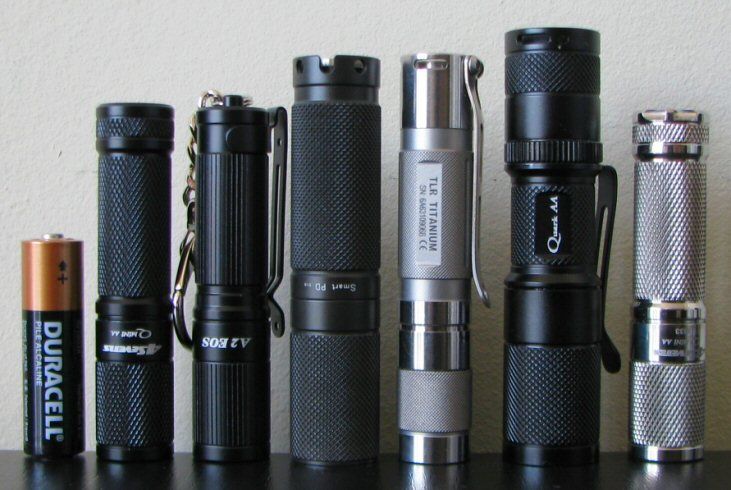
From left to right: Duracell AA, 4Sevens MiNi AA, ITP A2, NiteCore D10, DST TLR Titanium, 4Sevens Quark AA, 4Sevens MiNi Titanium AA.
As you can see, the lights are indeed quite small for their respective classes. Basically, you don't get much smaller than this! Like the popular 1xAAA ITP/Maratac lights, the aluminum body construction seems thin (i.e. body walls), but is still serviceable. The stainless steel versions are of course more sturdy, due to the source material used
Like the A3, knurling has been replaced with slight length-wise ridge detail (which makes it a little harder to twist one-handed). Finish was good on both my samples – no chips or blemishes.

In keeping with the minimalist build, the head has a simple contact board. Those with eagle eyes will note the extreme similarity to the 4Sevens Mini lights …
Note that the threads were somewhat "gritty" on both samples. Although this didn't interfere with operation, I recommend you clean them thoroughly upon arrival (and maybe even apply a small amount of a good quality non-conducting lube).
The lights all use a removable spring for the negative contact, which should reduce the risk of accidentally crushing a cell (always a concern on other twisty lights with posts).
Pocket clip is user-removable, and seems to fit on the light fairly snugly. :thumbsup:
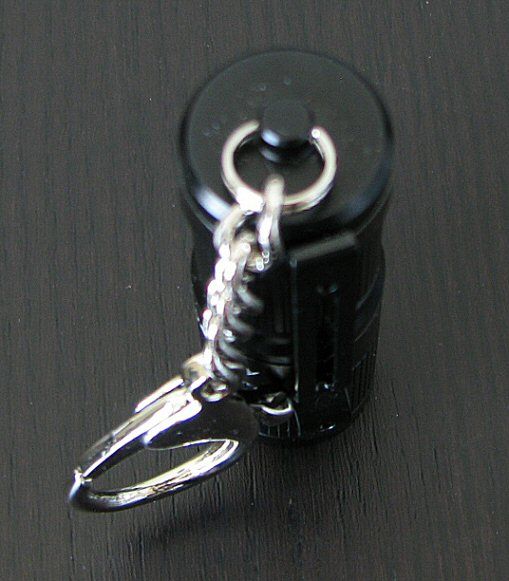
Like the A3, the A1/A2 can't tailstand due to the attached keychain clip. :sigh:

The lights feature the low profile Cree XP-E emitter, with a fairly basic output bin (Q5). Reflector is not overly deep, but heavily textured.
And now for the requisite white wall hunting . To begin, here are the 1xCR123A lights on Max with on AW RCR, about 0.5 meters from a white wall:
. To begin, here are the 1xCR123A lights on Max with on AW RCR, about 0.5 meters from a white wall:


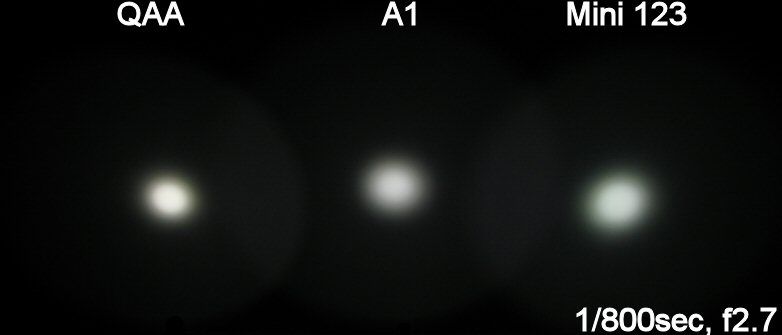
And now the 1xAA lights, on Sanyo eneloop, about 0.5 meters from a white wall:



As expected, beam pattern is fairly good for a general purpose light. Tint was quite acceptable on both my samples, although slightly on the cool side of cool white (with maybe a bit of a pinkish hue - YMMV). For those of you not familiar with tint bins, please see my Colour tint comparison and the summary LED tint charts found here.
As an aside, you will note the strong beam pattern similarity to the 4Sevens Mini lights. It's a little more than that – if you check out my review of those lights, you will see they share an almost identical build with the A1/A2. Sure, the Minis have a XP-G R5 emitter and different lanyard attachment and aggressive knurling, but the build difference between the Minis and the A1/A2 is very much similar to the Maratac compared to the ITP A3. In fact, the head/body tubes are interchangeable between the Minis and ITP A1/A2 …
User Interface
The A1/A2 use a slight modification from the original 1xAAA ITP A3 Upgraded/Maratac user interface – the sequence is now Lo > Med > Hi (instead of the A3's Med > Lo > Hi).
To use the A1 or A2, simply fully tighten the head and it comes on in Low. Do a rapid twist off-on and the light advances to Medium. Do another rapid off-on twist and the light advances to Hi. Wait a few seconds before re-activating the light after turning off, and it returns to default Low.
This cycle continues indefinitely - keep doing off-on twists to run through all the sequences in order again. There is no strobe or SOS mode on any of these lights.
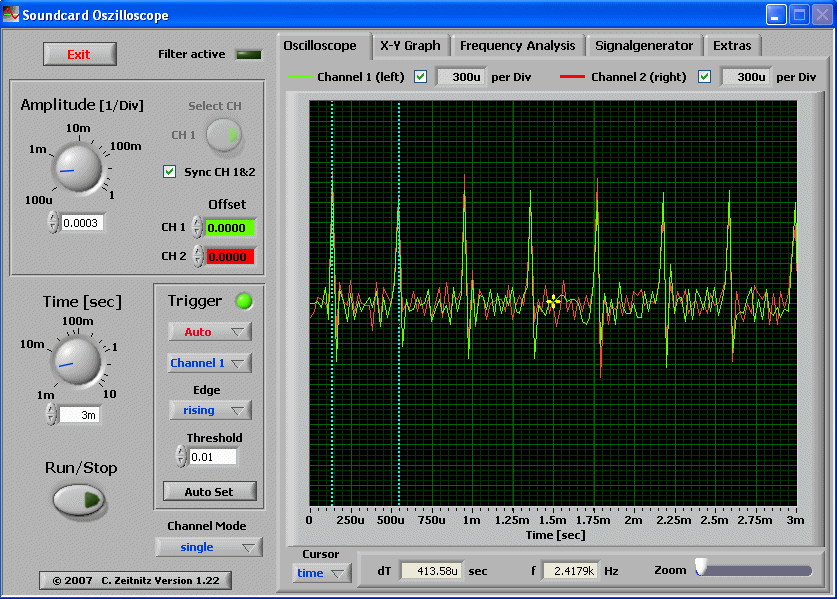
PWM frequency has greatly improved from the original ITP A3 Upgraded. Instead of the original visible 200 Hz, you now get an undetectable ~2.43 kHz. :thumbsup:
Note once again that this is the exact same frequency as the 4Sevens Minis (do I sound like a broken record? ).
).
Testing Method: All my output numbers are relative for my home-made light box setup, a la Quickbeam's flashlightreviews.com method. You can directly compare all my relative output values from different reviews - i.e. an output value of "10" in one graph is the same as "10" in another. All runtimes are done under a cooling fan, except for the extended run Lo/Min modes (i.e. >12 hours) which are done without cooling.
Throw values are the square-root of lux measurements taken at 1 meter from the lens, using a light meter.
Throw/Output Summary Chart:




On standard primary batteries, the A1/A2 strike a good balance between output and runtime (i.e. in keeping with their small size, they are not maximally driven). It's a different matter on 3.7V Li-ion – on both 1xRCR and 1x14500, the A1/A2 are clearly driven very hard. Frankly, I don't consider these levels very safe for extended run – the lights will heat up very quickly.
Frankly, I don't consider these levels very safe for extended run – the lights will heat up very quickly.
As expected for XP-E emitters, throw is not as great as earlier XR-E-based lights.
Lo mode is similar to other 3-stage lights.
Output/Runtime Comparison:
Let's start with the A1 runtimes:
Note: Effective January 2010, all CR123A runtimes are now performed solely on Titanium Innovations batteries sponsored by BatteryJunction.com. You can compare the generally excellent performance of these CR123A cells relative to the Duracell/Surefire cells used in all my earlier reviews here. I have marked all the new runtimes of lights with Titanium Innovations CR123As on the graphs with an "*".

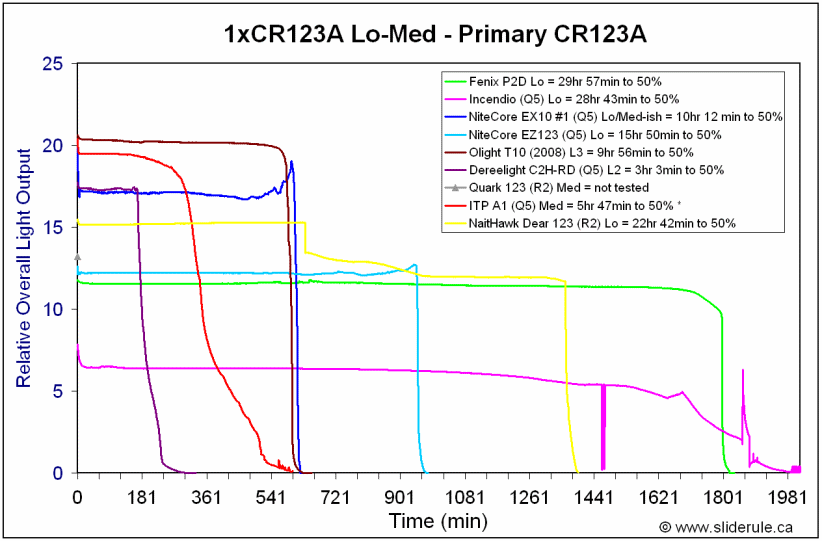


And now the A2 runtimes:

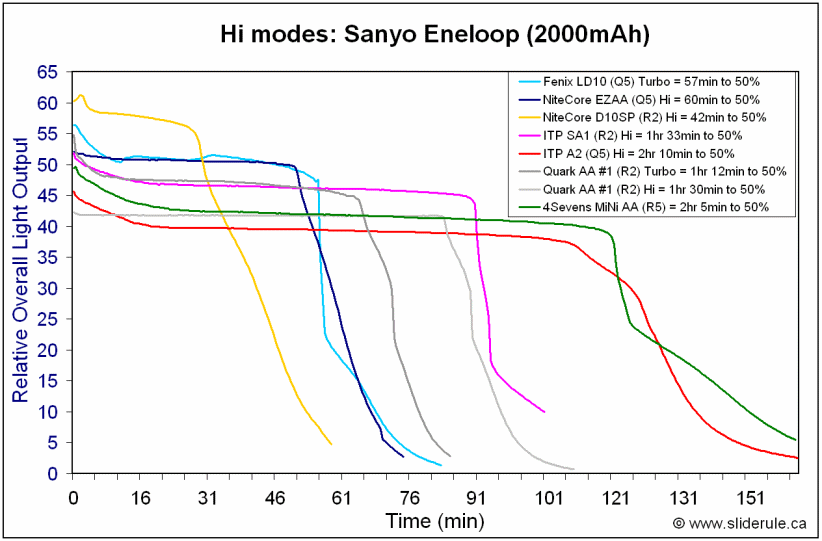





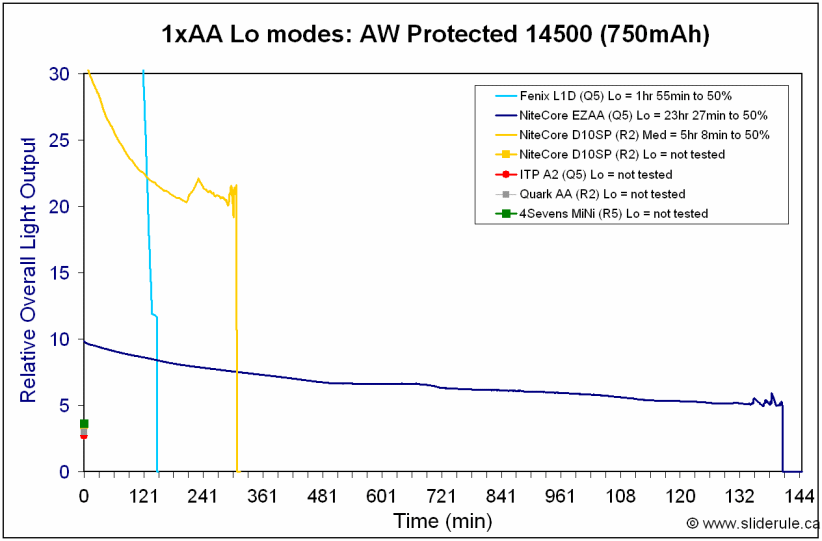
Once again, you will note that the circuit performance on all levels is virtually identical to the 4Sevens Mini lights (once you take into account their R5 output bin compared to the lower Q5 in the A1/A2). Coupled with identical PWM frequencies, it thus seems that it isn't only a physical build similarity that they share – the basic operation circuit mode is identical. oo:
oo:
Output/runtime efficiency on the Medium output setting is ok, but typically not as high as more expensive lights.
Potential Issues
Body wall construction is fairly thin, in keeping with a budget build. Although not at as great a risk of crushing as 1xAAA lights, I would still be careful with the aluminum A1/A2 (i.e. try to not sit on them ).
).
Max output on 1x3.7V Li-ion (i.e. 1xRCR or 1x14500) is too high for such a small build light. I recommend you do not run these lights on max on this battery source – or limit yourself to short periods of time only.
Preliminary Observations
The ITP A3s (including the Maratac variant) really took the 1xAAA market by storm when they came out. Soon afterward, a number of makers were producing simple, tiny, easy-to-use twisty 1xAAA lights will similar or upgraded circuits.
The A1/A2 are a reasonable progression of this design motif into the 1xCR123A/1xAA worlds. I quite like the much higher PWM frequency (now undetectable by eye) and revised Lo > Med > Hi output sequence. :thumbsup: Mode spacing seems good for a 3-stage light, although I would like to see the overall efficiency be a bit higher on Medium.
The main issue here is on 1xRCR/1x14500 - the light is driven very hard on max (i.e. much harder than on primary cells). Since ITP explicitly supports these battery types, I strongly recommend you keep this in mind and do NOT run these lights this way for any length of time. :tsk:
Overall build quality seems similar to the A3, in keeping with the budget status. My only real complaint with the ITP build is the lack of tailstanding due to the keychain attachment clip. :shrug: But this is a minor quibble for the price (I do like the included pocket clip, for example).
Interestingly, build and basic circuit performance of the ITP A1/A2 are remarkably similar to the 4Sevens Mini 123 and Mini AA. The build difference between these lights is reminiscent of the Maratac/ITP difference (see my Mini review for more details). Of particular note – the heads and bodies of the 4Sevens Minis are interchangeable with the ITP A1/A2. Circuit-wise, the ITP lights lack the extra hidden modes of the 4Sevens lights (and only come with a Q5 output bin), but otherwise seem comparable.
Circuit-wise, the ITP lights lack the extra hidden modes of the 4Sevens lights (and only come with a Q5 output bin), but otherwise seem comparable.
If you are looking the best budget deal on a simple, small twisty light, the ITP A-series family is hard to beat. For those looking for comparable performance with a few more extras and upgrades, I recommend you check out my 4Sevens Mini-series review. Either way you go, I think you will be fairly happy with what you get for the price.
Warning: Pic heavy, as usual.
Specifications for A1/A2, according to BatteryJunction.com and GoingGear.com:
- LED Type: Cree XP-E Q5
- Function: Low-Med-High
- Finish: HA Type 3
- Reflector: Orange Peel Reflector
- Lens:Anti-shattering ultra clear lens, anti-scratching and anti-slip
- Water and Dust Resistant to IP68
- Switch: Head Twisty Switch
- Mil-spec: MIL-STD-810F
- Battery Type: A1 EOS: 1 x CR123A, 1 x RCR123A, 1 x 16340 Battery; A2 EOS: 1 x Alkaline, 1 x NI-MH Battery
- Functions and Runtime: A1 EOS: Low 1.8 lm (150 Hrs) --- Med 35 lm (8 Hrs) --- High 190 lm (1.6 Hrs); A2 EOS: Low 1.5 lm (60 Hrs) --- Med 18 lm (7 Hrs) --- High 80 lm (2 Hrs)
- Standard Accessories: 1 x Keychain, 1 x Clip, 2 x O-rings, 1 x Manual
- Size and Weight: A1 EOS: L 59.8mm (2.35'') x D 20.4mm (0.8''), 22g (Excluding Battery); A2 EOS: L 75.5mm (2.97'') x D 17.6mm (0.69''), 22g (Excluding Battery)
- MSRP: $25 for aluminum versions, $33 for stainless steel versions

Packaging for the ITP A1/A2 EOS lights is similar to the earlier A3. All lights come in a fairly basic box with the light, attached keychain ring, removable pocket clip, spare o-rings, and user manual.
To keep this simple, I focus most of the pics on the A1 – the A2 looks quite comparable.




From left to right: Surefire CR123A, 4Sevens MiNi 123, ITP A1, NaitHawk Dear 123, Nitecore EX10, 4Sevens Quark 123, Novatac 120P, 4Sevens MiNi Titanium 123.

From left to right: Duracell AA, 4Sevens MiNi AA, ITP A2, NiteCore D10, DST TLR Titanium, 4Sevens Quark AA, 4Sevens MiNi Titanium AA.
As you can see, the lights are indeed quite small for their respective classes. Basically, you don't get much smaller than this! Like the popular 1xAAA ITP/Maratac lights, the aluminum body construction seems thin (i.e. body walls), but is still serviceable. The stainless steel versions are of course more sturdy, due to the source material used
Like the A3, knurling has been replaced with slight length-wise ridge detail (which makes it a little harder to twist one-handed). Finish was good on both my samples – no chips or blemishes.

In keeping with the minimalist build, the head has a simple contact board. Those with eagle eyes will note the extreme similarity to the 4Sevens Mini lights …
Note that the threads were somewhat "gritty" on both samples. Although this didn't interfere with operation, I recommend you clean them thoroughly upon arrival (and maybe even apply a small amount of a good quality non-conducting lube).
The lights all use a removable spring for the negative contact, which should reduce the risk of accidentally crushing a cell (always a concern on other twisty lights with posts).
Pocket clip is user-removable, and seems to fit on the light fairly snugly. :thumbsup:

Like the A3, the A1/A2 can't tailstand due to the attached keychain clip. :sigh:

The lights feature the low profile Cree XP-E emitter, with a fairly basic output bin (Q5). Reflector is not overly deep, but heavily textured.
And now for the requisite white wall hunting



And now the 1xAA lights, on Sanyo eneloop, about 0.5 meters from a white wall:



As expected, beam pattern is fairly good for a general purpose light. Tint was quite acceptable on both my samples, although slightly on the cool side of cool white (with maybe a bit of a pinkish hue - YMMV). For those of you not familiar with tint bins, please see my Colour tint comparison and the summary LED tint charts found here.
As an aside, you will note the strong beam pattern similarity to the 4Sevens Mini lights. It's a little more than that – if you check out my review of those lights, you will see they share an almost identical build with the A1/A2. Sure, the Minis have a XP-G R5 emitter and different lanyard attachment and aggressive knurling, but the build difference between the Minis and the A1/A2 is very much similar to the Maratac compared to the ITP A3. In fact, the head/body tubes are interchangeable between the Minis and ITP A1/A2 …
User Interface
The A1/A2 use a slight modification from the original 1xAAA ITP A3 Upgraded/Maratac user interface – the sequence is now Lo > Med > Hi (instead of the A3's Med > Lo > Hi).
To use the A1 or A2, simply fully tighten the head and it comes on in Low. Do a rapid twist off-on and the light advances to Medium. Do another rapid off-on twist and the light advances to Hi. Wait a few seconds before re-activating the light after turning off, and it returns to default Low.
This cycle continues indefinitely - keep doing off-on twists to run through all the sequences in order again. There is no strobe or SOS mode on any of these lights.

PWM frequency has greatly improved from the original ITP A3 Upgraded. Instead of the original visible 200 Hz, you now get an undetectable ~2.43 kHz. :thumbsup:
Note once again that this is the exact same frequency as the 4Sevens Minis (do I sound like a broken record?
Testing Method: All my output numbers are relative for my home-made light box setup, a la Quickbeam's flashlightreviews.com method. You can directly compare all my relative output values from different reviews - i.e. an output value of "10" in one graph is the same as "10" in another. All runtimes are done under a cooling fan, except for the extended run Lo/Min modes (i.e. >12 hours) which are done without cooling.
Throw values are the square-root of lux measurements taken at 1 meter from the lens, using a light meter.
Throw/Output Summary Chart:




On standard primary batteries, the A1/A2 strike a good balance between output and runtime (i.e. in keeping with their small size, they are not maximally driven). It's a different matter on 3.7V Li-ion – on both 1xRCR and 1x14500, the A1/A2 are clearly driven very hard.
As expected for XP-E emitters, throw is not as great as earlier XR-E-based lights.
Lo mode is similar to other 3-stage lights.
Output/Runtime Comparison:
Let's start with the A1 runtimes:
Note: Effective January 2010, all CR123A runtimes are now performed solely on Titanium Innovations batteries sponsored by BatteryJunction.com. You can compare the generally excellent performance of these CR123A cells relative to the Duracell/Surefire cells used in all my earlier reviews here. I have marked all the new runtimes of lights with Titanium Innovations CR123As on the graphs with an "*".




And now the A2 runtimes:








Once again, you will note that the circuit performance on all levels is virtually identical to the 4Sevens Mini lights (once you take into account their R5 output bin compared to the lower Q5 in the A1/A2). Coupled with identical PWM frequencies, it thus seems that it isn't only a physical build similarity that they share – the basic operation circuit mode is identical.
Output/runtime efficiency on the Medium output setting is ok, but typically not as high as more expensive lights.
Potential Issues
Body wall construction is fairly thin, in keeping with a budget build. Although not at as great a risk of crushing as 1xAAA lights, I would still be careful with the aluminum A1/A2 (i.e. try to not sit on them
Max output on 1x3.7V Li-ion (i.e. 1xRCR or 1x14500) is too high for such a small build light. I recommend you do not run these lights on max on this battery source – or limit yourself to short periods of time only.
Preliminary Observations
The ITP A3s (including the Maratac variant) really took the 1xAAA market by storm when they came out. Soon afterward, a number of makers were producing simple, tiny, easy-to-use twisty 1xAAA lights will similar or upgraded circuits.
The A1/A2 are a reasonable progression of this design motif into the 1xCR123A/1xAA worlds. I quite like the much higher PWM frequency (now undetectable by eye) and revised Lo > Med > Hi output sequence. :thumbsup: Mode spacing seems good for a 3-stage light, although I would like to see the overall efficiency be a bit higher on Medium.
The main issue here is on 1xRCR/1x14500 - the light is driven very hard on max (i.e. much harder than on primary cells). Since ITP explicitly supports these battery types, I strongly recommend you keep this in mind and do NOT run these lights this way for any length of time. :tsk:
Overall build quality seems similar to the A3, in keeping with the budget status. My only real complaint with the ITP build is the lack of tailstanding due to the keychain attachment clip. :shrug: But this is a minor quibble for the price (I do like the included pocket clip, for example).
Interestingly, build and basic circuit performance of the ITP A1/A2 are remarkably similar to the 4Sevens Mini 123 and Mini AA. The build difference between these lights is reminiscent of the Maratac/ITP difference (see my Mini review for more details). Of particular note – the heads and bodies of the 4Sevens Minis are interchangeable with the ITP A1/A2.
If you are looking the best budget deal on a simple, small twisty light, the ITP A-series family is hard to beat. For those looking for comparable performance with a few more extras and upgrades, I recommend you check out my 4Sevens Mini-series review. Either way you go, I think you will be fairly happy with what you get for the price.
Last edited:



